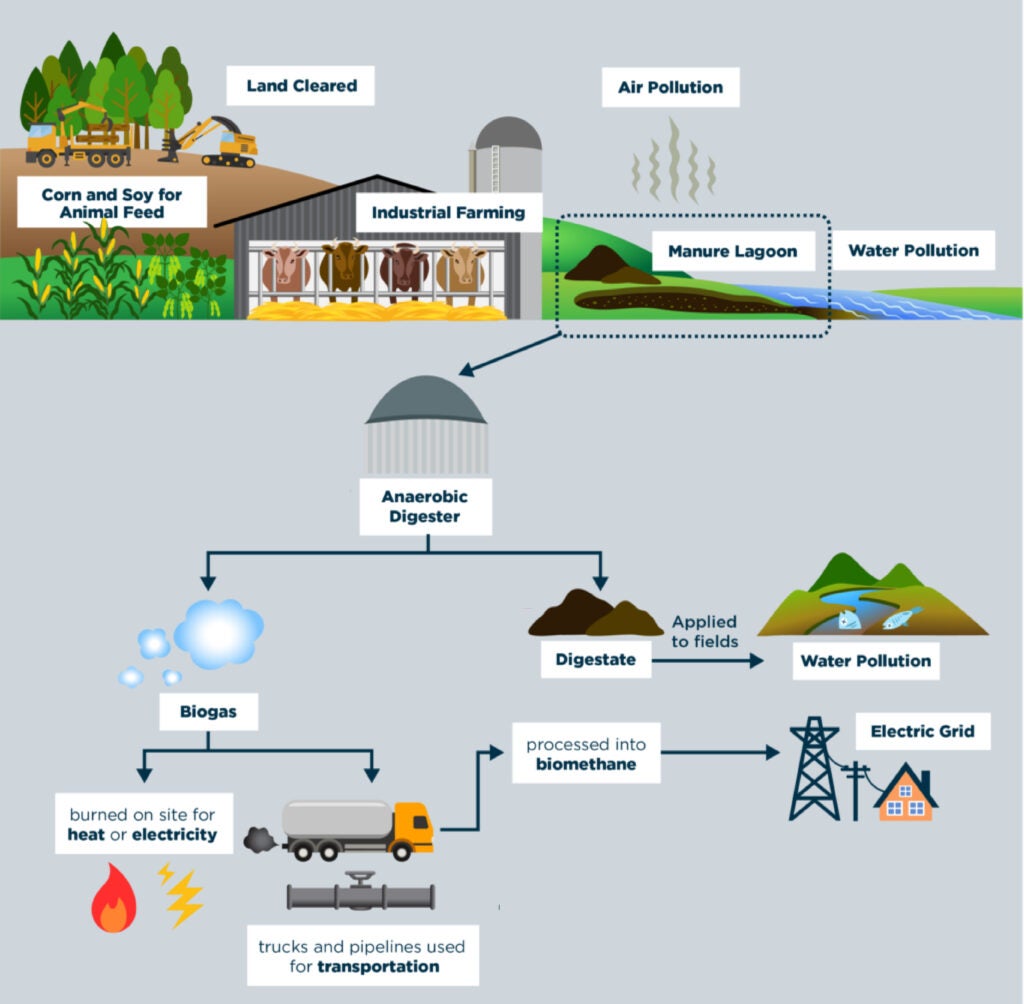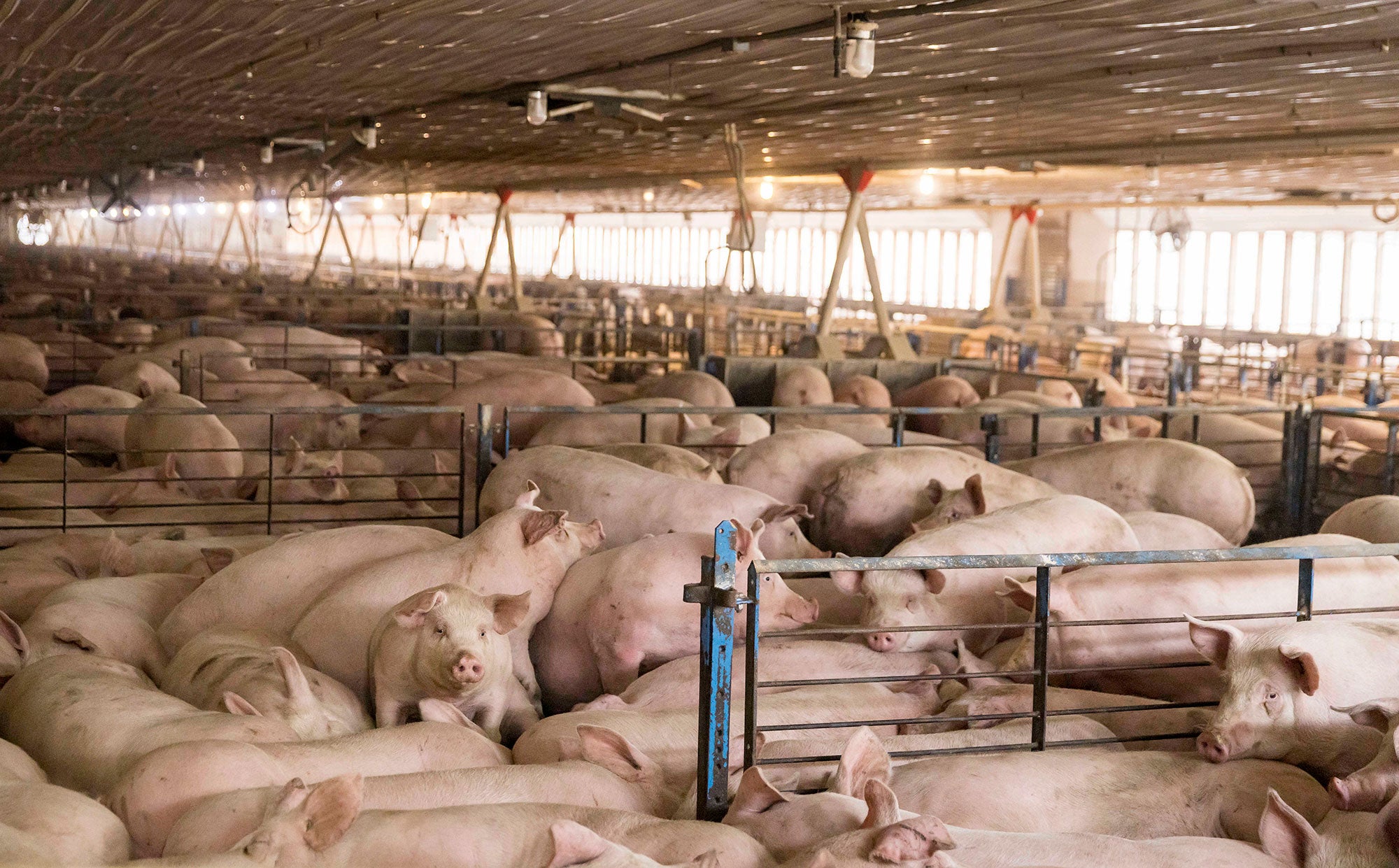No Clean Electricity Tax Credits for Dirty Manure Biogas
Earthjustice and partners urge the Treasury Department to prohibit electricity producers that use biogas from animal manure from receiving Clean Electricity Tax Credits.
In a groundbreaking effort to reduce agriculture’s significant contributions to climate change, the Inflation Reduction Act (IRA) supports agricultural practices that address the sector’s greenhouse gas (GHG) emissions. Given that our food system drives about one-third of climate change, it is imperative that the IRA’s support goes to practices that provide true climate benefits. Anaerobic digesters, which capture some of the methane from manure storage at industrial animal factories to produce so-called biogas, are not one of these practices.
Earlier this month, Earthjustice and 51 other organizations submitted comments to the Treasury Department, telling it just that. The Department administers the IRA’s Clean Electricity Tax Credits, which are for electricity production facilities that have a GHG emissions rate of zero or lower, meaning that the Department has determined that they emit no GHGs at all. For facilities that use biogas from animal manure, the agency must assess their emissions, including any emissions and reductions related to their fuel source, to ensure that their overall GHG emissions rate is zero or lower. As our comments explain, facilities that use biogas from animal manure cannot meet this standard.
Understanding biogas and its tremendous GHG emissions requires understanding meat and dairy production today. Most of our meat and dairy comes from massive, industrial animal factories, commonly called concentrated animal feeding operations or CAFOs. These factories often hold many thousands of animals in crowded buildings. These animals generate a lot of waste. According to the Centers for Disease Control and Prevention, livestock in the United States generate up to 20 times more manure than the amount of waste that the human population produces. Dairy and swine operations typically move the manure around with water and store it in liquid form in massive pits, and they dispose of it by spreading it on fields. As the manure decomposes, it releases methane and nitrous oxide, two climate super pollutants. Methane is over 80 times more potent than carbon dioxide on a 20-year time scale, and nitrous oxide is almost 300 times more potent over a 100-year time scale.
Anaerobic digesters at animal factories typically consist of plastic covers over the pits that capture some of the methane and then direct it either to a burner to generate electricity on-site or, after the gas is cleaned up, to a pipeline for burning elsewhere. (They are usually much more rudimentary than digesters at sewage treatment plants, which typically are steel tanks.)

Chloe Waterman & Molly Armus, Biogas or Bull****? The Deceptive Promise of Manure Biogas as a Methane Solution (2024).
Digesters are touted as an effective way to reduce manure methane emissions and a source of “clean” energy, since they rely on organic waste instead of fossil fuels. But what happens at the waste pit is not the full story, and there is nothing clean about biogas. Congress wisely directed the Treasury Department to look beyond the waste pit and consider GHG emissions from the full lifecycle of biogas production. Doing so makes clear that biogas production generates tremendous GHG emissions from:
- Animal feed production. Producing grain for the animals confined in industrial animal factories uses over 127 million acres of land in the U.S. Converting native forests and grasslands to cropland releases stored carbon from the soil and prior native vegetation and, when used for feed production, increases demand elsewhere for land for food. This carbon opportunity cost, well-recognized by science (see Carbon opportunity cost increases carbon footprint advantage of grain-finished beef, The carbon opportunity cost of animal-sourced food production on land, and Including CO2 implications of land occupation in LCAs—method and example for livestock products), significantly increases the climate impact of feed production. And, applying nitrogen fertilizers to crops releases large amounts of nitrous oxide, in addition to the significant emissions from producing the fertilizer and other agrochemicals.
- Enteric fermentation. Unlike humans, cows and other ruminant animals generate a huge amount of methane as they digest food, and every breath and belch release this methane. Nationwide, cows belch almost as much methane as released by the entire oil and gas sector.
- Digester and biogas transportation infrastructure leaks and malfunctions. On average, digesters leak 3%-5% of the methane they initially capture. And during periods of repair, maintenance, malfunction, or other suboptimal performance, digesters can release 13%-25% of methane initially captured. In addition, infrastructure used to transport biogas also leaks, releasing more methane.
- Burning biogas to produce electricity. Combusting biogas to produce electricity generates carbon dioxide (not to mention other air pollution).
- Digestate storage and disposal. The sludge left in the pits after the methane is captured, called digestate, emits both methane and nitrous oxide when stored in pits and applied to fields. In fact, digestate emits more nitrous oxide than manure that has not been digested.
Digesters leave the majority of the GHG emissions described above unaddressed. The figures below, which show the average lifecycle GHG emissions associated with producing 1 kilogram (kg) of milk and 1 kg of meat from swine, show that manure-related emissions are less than a quarter of total emissions. As a result, even if digesters could reduce all manure-related emissions, they cannot cancel out biogas’s substantial lifecycle emissions.

Average lifecycle GHG emissions for dairy production in the United States.

Average lifecycle GHG emissions for swine production in the United States.
GHG reductions from digesters look even less compelling when compared to other options for managing manure. Digesters only work for operations that store liquid manure in uncovered pits, which generate the most methane. Other practices — such as solid-liquid-separation, aeration, acidification, decreased storage time, composting, storage temperature optimization, and dry manure management — generate much less methane in the first place.
Not only does supporting anaerobic digesters fail to address animal factories’ GHG emissions, but it also creates perverse incentives. For starters, encouraging electricity producers to purchase biogas from animal factories would incentivize them to continue producing methane, rather than reduce or eliminate it. In fact, it would reward them for choosing and continuing to use the most-polluting system. Some dairies in California, which already subsidizes biogas production, are profiting more from methane production than from milk. In addition, recent evidence suggests that supporting biogas production incentivizes operators to expand their herd sizes so they can generate more manure methane, which causes even more pollution.
Supporting biogas also has many other unacceptable results. Funding for biogas benefits larger, more-polluting animal factories over smaller operations, at a time when industrial animal production is already decimating small farms. In the case of programs meant to fund climate-smart practices, which are already vastly over-subscribed, funding digesters — which can cost over $1 million apiece — diverts limited public money from practices that offer true climate benefits. And, adding digesters at animal factories exacerbates the environmental injustice they cause. Ample evidence shows that animal factories disproportionately harm communities of color and low-income communities across the country. Digesters, which also cause air and water pollution, will only worsen this environmental injustice.
We hope the Treasury Department will not follow in the footsteps of other agencies that have mistakenly chosen to use taxpayer dollars to subsidize biogas. For example, Earthjustice and other organizations have urged the Natural Resources Conservation Service not to include digesters on its annual list of agricultural practices that are eligible for “climate-smart” funding. And, at the state level, Earthjustice and others have called on the California Air Resources Board to stop investing in biogas through California’s Low Carbon Fuel Standard.
These and other programs can play an important role in addressing the climate crisis, but only if they support practices that truly reduce or eliminate GHG emissions and do not cause additional pollution and injustice. Anaerobic digesters at industrial animal factories are a false climate solution that do not fit the bill.
Earthjustice’s Sustainable Food and Farming program aims to make our nation’s food system safer and more climate friendly.
